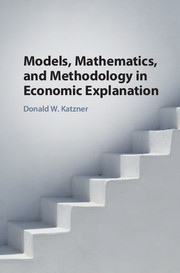Book contents
- Frontmatter
- Dedication
- Contents
- Preface
- Introduction
- 1 Science and Economics
- 2 Economic Models and Explanation
- 3 The Stages of Model Building in Economics
- 4 Models and Mathematics
- 5 Models and Measurement (or Lack Thereof)
- 6 Issues Relating to the Construction of Models from Scratch
- 7 An Example: The Efficiency of Organizational Forms
- 8 The Implicit Assumption Requirements of Later-Stage Model Building
- 9 Ordinality and the Adequacy of Analytic Specification
- 10 Categories of Models
- 11 Conclusion
- Index
7 - An Example: The Efficiency of Organizational Forms
Published online by Cambridge University Press: 26 October 2017
- Frontmatter
- Dedication
- Contents
- Preface
- Introduction
- 1 Science and Economics
- 2 Economic Models and Explanation
- 3 The Stages of Model Building in Economics
- 4 Models and Mathematics
- 5 Models and Measurement (or Lack Thereof)
- 6 Issues Relating to the Construction of Models from Scratch
- 7 An Example: The Efficiency of Organizational Forms
- 8 The Implicit Assumption Requirements of Later-Stage Model Building
- 9 Ordinality and the Adequacy of Analytic Specification
- 10 Categories of Models
- 11 Conclusion
- Index
Summary
It is now appropriate to provide an example of model construction in economics that illustrates previous discussion. To display fully the depth and significance of the use of models in analysis and explanation, it is necessary that the example be both detailed and complete. Furthermore, to be able to emphasize the power of model building independently of quantification (remember that arithmomorphic extraction does not imply measurement), the example focuses almost exclusively on non-quantifiable entities. The particular example under consideration is a model whose objective is twofold: The first is to describe the possible structure of an economic entity so as to explain its characteristics and how itmight operate and, as a by-product to explain the single collection of observed variable values that the entity produces. The style of the model's output clearly places the model in the single-output category. As an analytical edifice in and of itself, then, the explanatory competence of the full model does not admit of empirical tests. However, the second objective is to extend the model to permit the derivation within its framework of behavioral functions subject to multiple observations over time, and that, therefore, are capable of empirical estimation and test. In this context, the style of the model's outputs has changed and the model moves into the multi-output category. Discussion begins with some general introductory, motivating, and suggestive remarks that are prior to stage (i) of model building and to distinctions between dialectical and arithmomorphic ideas.
For a long time economists have believed that certain ways of organizing firms are more efficient than others. Adam Smith, for example, thought that a firm producing pins in which employees specialized in straightening wire, cutting wire, making points, etc. would be more efficient than one in which each worker produced complete pins by himself alone. However, recent approaches to this problem (e.g., Beckmann [1], Calvo and Wellisz [3], Sah and Stiglitz [16], and Williamson [18, 19]) have tended to de-emphasize the technological aspects of production and center instead on certain social relations among individuals in the firm. These social relations arise in that some workers are above other workers in the firm's authority structure; they are significant because it is the social interactions between those above and those below that seem to be responsible for coordinating effort and seeing production through.
- Type
- Chapter
- Information
- Models, Mathematics, and Methodology in Economic Explanation , pp. 144 - 175Publisher: Cambridge University PressPrint publication year: 2017



